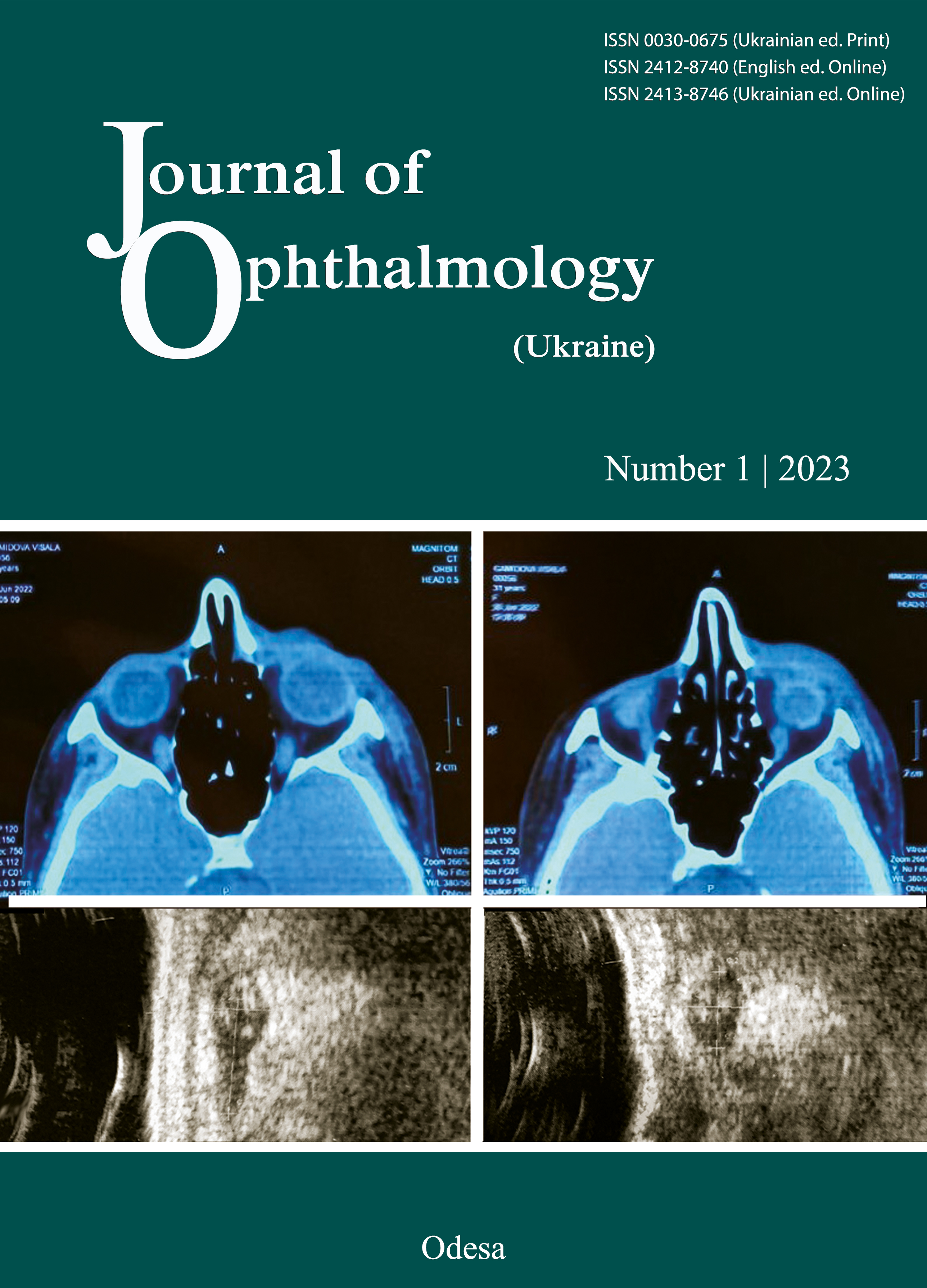Особливості регресу різних стадій ретинобластоми при первинній поєднаній (інтравітреальній + системній) поліхіміотерапії та в комбінації з консолідуючою терапією
DOI:
https://doi.org/10.31288/oftalmolzh202311418Анотація
Актуальність. Повний регрес ретинобластоми (РБ) – це її остаточні зміни, які зазнає пухлина в ході органозберігаючого лікування. Вивчення типів регресу РБ, що формуються внаслідок застосування різних видів органозберігаючого лікування є важливим для оцінки його результатів.
Мета - вивчення формування типів регресу різних стадій ретинобластоми після первинної поєднаної поліхіміотерапії (ППХТ) у комбінації з консолідуючою терапією.
Матеріал та методи. Проаналізовані типи регресу РБ у 89 дітей (119 очей) віком від 1,5 до 77 місяців з РБ після проведення ППХТ та різних видів консолідуючого лікування. З них 37 дітей (37 очей) були з односторонньою РБ, 52 дитини (82 ока) ‒ з двосторонньою. Найбільш часто (67,2%) спостерігалася Т3 стадія РБ (за класифікацією ВООЗ), рідше (23,6%) діагностувалася Т2 стадія. Т1стадія спостерігалась лише в 9,2% – найчастіше вона була діагностована на парному "здоровому" оці при розповсюдженій Т3 стадії контрлатерального ока. На 16 очах (13%) мав місце мультифокальний тип росту. Кількість вогнищ коливалась від 1 до 3 на одному оці, в зв'язку з чим вона перевищувала кількість очей і дорівнювала 124.
Лікування проводилось за розробленою методикою ППХТ, яка передбачала інтравітреальне введення мелфалану в дозі 10-30 мкг в залежності від стадії пухлини, з наступною внутрішньовенною системною терапією (VEC-протокол).
Результати. В результаті первинної ППХТ виявлено формування різних типів регресу РБ. Після I курсу ППХТ для малих пухлин стадії Т1 характерним було формування II типу регресу, тоді як для стадій T2 та Т3 найбільш поширеним (60%) був III – проміжний тип регресу, що імовірно може свідчити про мозаїчний характер пухлини з наявністю менш диференційованих і відповідно більш злоякісних типів клітин, які скоріше реагували на ППХТ шляхом кальцифікації, оточених більш диференційованими та відповідно менш злоякісними, які реагували слабкіше. Після закінчення курса ППХТ для всіх стадій РБ була поява I типу (29%), що свідчило про остаточний регрес, при тому що III тип залишався у третині (33%) випадків. Відмінними рисами регресу після первинної ППХТ були: розфрагментація великих пухлин РБ (59,3%) з появою ретинальних і, рідше, вітреальних клонів і некротичних вогнищ, які розсмоктувались або кальцифікувались в процесі лікування; наявність різних типів регресу в одному оці при мультифокальному рості; трансформація одних типів регресу в інші в процесі лікування – частіше за все ІІ типу в ІІІ, а ІІІ – в І.
Посилання
Боброва НФ, Науменко ВА, Сорочинская ТА, Братишко АЮ, Комарницкая ТИ. Комбинация локальных методов воздействия на ретинобластому. Мат. Научно-практич. конф. c междунар. участ. «Филатовские чтения-2019»: 186-187.
Боброва НФ. Ретинобластома: монография. Одесса: Издательский центр, 2020. 324 с.
Боброва НФ, Сорочинская ТА. Комбинированная (интравитреальная и внутривенная) полихимиотерапия в системе органосохранного лечения ретинобластомы. Офтальмол. журн. 2011; 2: 38-44. https://doi.org/10.31288/oftalmolzh201123844
Боброва НФ, Сорочинська ТА, Троніна СА, Романова ТВ, Братішко ОЮ. Високодозова інтравітреальна хіміотерапія в лікуванні ретинобластоми високого ризику. Офтальмол. журн. 2022; 4: 23-27. https://doi.org/10.31288/oftalmolzh202242327
Abramson DH, Gerardi CM, Ellsworth RM, McCormick B, Sussman D, Turner L. Radiation regression patterns in treated retinoblastoma: 7 to 21 years later. J Pediatr Ophthalmol Strabismus. 1991;28(2):108-112. https://doi.org/10.3928/0191-3913-19910301-12
Chawla B, Jain A, Seth R, Azad R, Mohan VK, Pushker N, Ghose S. Clinical outcome and regression patterns of retinoblastoma treated with systemic chemoreduction and focal therapy: A prospective study. Indian J Ophthalmol. 2016 Jul;64(7):524-9. https://doi.org/10.4103/0301-4738.190143
Dunphy EB. The story of retinoblastoma: the Edward Jackson Memorial Lecture. Am J Ophthalmol. 1964; 58: 539-552. https://doi.org/10.1016/0002-9394(64)91368-6
Ellsworth RM. The practical management of retinoblastoma. Trans Am Ophthalmol Soc. 1969;67:462-534.
Friedman D, Himelstein B, Shields C, et al. Chemoreduction and local ophthalmic therapy for intraocular retinoblastoma. J Clin Oncol. 2000; 18: 12-17. https://doi.org/10.1200/JCO.2000.18.1.12
Ghassemi F, Rahmanikhah E, Roohipoor R, Karkhaneh R, Faegh A Regression patterns in treated retinoblastoma with chemotherapy plus focal adjuvant therapy. Pediatr Blood Cancer. 2013 Apr;60(4):599-604. doi: 10.1002/pbc.24333. Epub 2012 Oct 3. https://doi.org/10.1002/pbc.24333
Levy J, Frenkel S, Baras M, Neufeld M, Pe'er J. Calcification in retinoblastoma: histopathologic findings and statistical analysis of 302 cases. Br J Ophthalmol. 2011 Aug;95(8):1145-50. https://doi.org/10.1136/bjo.2010.193961
Lin CC, Tso MO. An electron microscopic study of calcification of retinoblastoma. Am J Ophthalmol. 1983; 96:765-74. https://doi.org/10.1016/S0002-9394(14)71922-1
Murphree A, Villablanca J, Deegan W, et al. Chemotherapy plus local treatment in the management of intraocular retinoblastoma. Arch Ophthalmol. 1996; 114: 1348-1356. https://doi.org/10.1001/archopht.1996.01100140548005
Palamar M, Thangappan A, Shields CL Evolution in regression patterns following chemoreduction for retinoblastoma. Arch Ophthalmol. 2011 Jun;129(6):727-30. https://doi.org/10.1001/archophthalmol.2011.137
Saup DN, Albert DM. Retinoblastoma: Clinical and histopathologic features. Hum Pathol 1982 : 13; 133-47. https://doi.org/10.1016/S0046-8177(82)80117-2
Singh AD, Garway-Heath D, Love S, Plowman PN, Kingston JE, Hungerford JL. Relationship of regression pattern to recurrence in retinoblastoma. Br J Ophthalmol.1993;77(1):12-16. https://doi.org/10.1136/bjo.77.1.12
Shields CL, Shields JA. Diagnosis and management of retinoblastoma. Cancer Control. 2004; 11(5): 317- 327. https://doi.org/10.1177/107327480401100506
Shields CL, Palamar M, Sharma P, Ramasubramanian A, Leahey A, Meadows AT, Shields JA Retinoblastoma regression patterns following chemoreduction and adjuvant therapy in 557 tumors. Arch Ophthalmol. 2009 Mar;127(3):282-90.
https://doi.org/10.1001/archophthalmol.2008.626
Xue К, Qian J, Han Yue, Yi-fei Yuan, Rui Zhang [Retinoblastoma regression patterns and results following chemoreduction and adjuvant therapy] [Article in Chinese] Zhonghua Yan Ke Za Zhi. 2012 Jul;48(7):625-30.
Zafar SN., Siddiqui SN., Zaheer N. Тumor Regression Patterns in Retinoblastoma. J Coll Physicians Surg Pak. 2016 Nov;26(11):896-899.
##submission.downloads##
Опубліковано
Як цитувати
Номер
Розділ
Ліцензія
Авторське право (c) 2023 Боброва Н. Ф., Троніна С. А., Сорочинська Т. А., Романова Т. В., Дембовецька Г. М., Шилик А.В., Довгань О.В.

Ця робота ліцензується відповідно до Creative Commons Attribution 4.0 International License.
Ця робота ліцензується відповідно до ліцензії Creative Commons Attribution 4.0 International (CC BY). Ця ліцензія дозволяє повторно використовувати, поширювати, переробляти, адаптувати та будувати на основі матеріалу на будь-якому носії або в будь-якому форматі за умови обов'язкового посилання на авторів робіт і первинну публікацію у цьому журналі. Ліцензія дозволяє комерційне використання.
ПОЛОЖЕННЯ ПРО АВТОРСЬКІ ПРАВА
Автори, які подають матеріали до цього журналу, погоджуються з наступними положеннями:
- Автори отримують право на авторство своєї роботи одразу після її публікації та назавжди зберігають це право за собою без жодних обмежень.
- Дата початку дії авторського права на статтю відповідає даті публікації випуску, до якого вона включена.
ПОЛІТИКА ДЕПОНУВАННЯ
- Редакція журналу заохочує розміщення авторами рукопису статті в мережі Інтернет (наприклад, у сховищах установ або на особистих веб-сайтах), оскільки це сприяє виникненню продуктивної наукової дискусії та позитивно позначається на оперативності і динаміці цитування.
- Автори мають право укладати самостійні додаткові угоди щодо неексклюзивного розповсюдження статті у тому вигляді, в якому вона була опублікована цим журналом за умови збереження посилання на первинну публікацію у цьому журналі.
- Дозволяється самоархівування постпринтів (версій рукописів, схвалених до друку в процесі рецензування) під час їх редакційного опрацювання або опублікованих видавцем PDF-версій.
- Самоархівування препринтів (версій рукописів до рецензування) не дозволяється.












